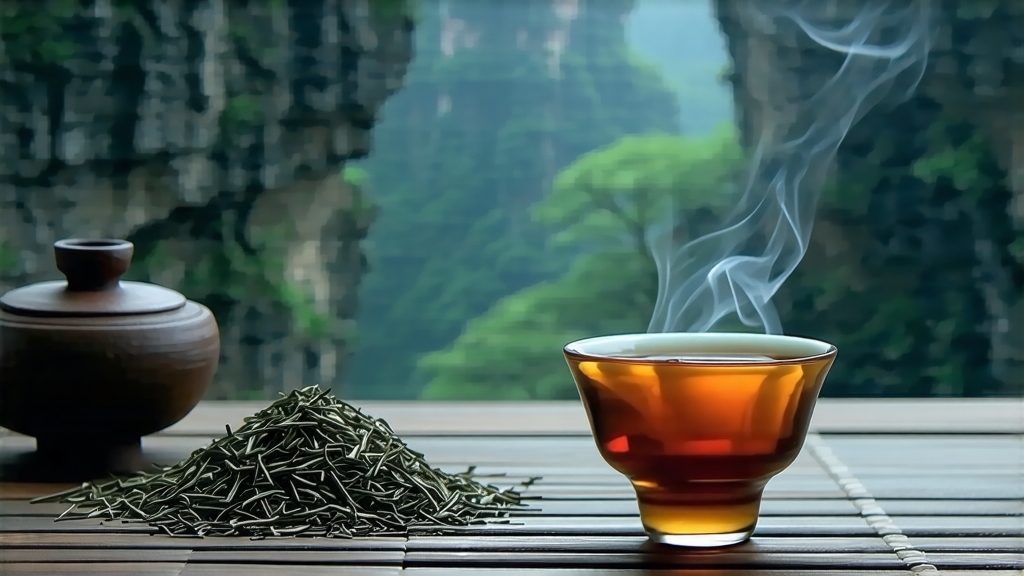
High in the UNESCO-listed Wuyi Mountains of northern Fujian, where the Nine-Bend River coils like a silk ribbon around towering crimson cliffs, grows a tea that locals call “Water Immortal.” To the outside world it is Shui Xian, an oolong cultivar whose name evokes both Daoist legend and liquid poetry. Unlike the more famous Da Hong Pao, Shui Xian has quietly sustained mountain villages for three centuries, perfuming the air with orchid-gardenia aromas while embedding the flavor of volcanic rock into every leaf. This article invites the international tea traveler to discover why Shui Xian is considered the most approachable yet profound of Wuyi’s “rock teas” (yancha), and how to unlock its mineral-sweet personality in your own kitchen.
Legend and lineage
The story begins around 1680, during the early Qing dynasty, when a traveling scholar became lost in the Wuyi mist. Thirsty and feverish, he drank from a spring guarded by an ancient tree whose leaves exuded an intoxicating scent. Upon recovering, he named the tree “Shui Xian,” water immortal, and took cuttings back to his hometown of Jianyang. The cuttings thrived, but—crucially—when they were reintroduced to the rocky Wuyi micro-climate two generations later, the tea absorbed the cliff minerals and developed the signature “yan yun” (rock rhyme) that still defines authentic Wuyi Shui Xian today. Genetic testing shows the cultivar is a distinct strain of Camellia sinensis var. sinensis, medium-leaf, semi-erect, with serrated edges that turn inward like tiny jade hooks. Its cambium layer carries an unusually high ratio of calcium to potassium, a trait geobotanists link to the dolomitic weathering of Wuyi tuff.
Terroir: cliffs, mist, and “rock rhyme”
The core producing zone is a 60 km² belt inside the Wuyi Nature Reserve where daytime cliff-face temperatures can reach 40 °C while nighttime river mist drops to 18 °C. This 22-degree diurnal swing forces the plant to convert daytime sugars into nighttime aromatic esters, creating the honey-orchid top note. Meanwhile, the porous purple-red rock leaches iron, magnesium, and rare earth elements into the shallow soil; the roots absorb these minerals and translocate them into polyphenol backbones, yielding the wet-stone finish that Chinese tasters describe as “the echo of rock.” Authentic garden plots are so steep that farmers still use woven rattan chairs lowered from iron rings hammered into the cliff to pluck the leaves, a spectacle best witnessed during the late-April spring flush.
Pluck standard and leaf architecture
Only the “kai mian” (open-face) pluck is accepted: the terminal bud plus three unfolded leaves, picked when the third leaf’s serration turns slightly yellowish, indicating optimal pectin content. This larger pluck provides the cellulose needed for repeated rolling and baking without leaf fracture. Experienced pickers listen for a soft “pa” sound when the petiole snaps—evidence of high pectin that will later translate into thick, syrupy liquor.
Withering: the first dialogue between leaf and fire
Leaves are spread on bamboo screens set into cliff-side alcoves where reflected river light creates a gentle, dappled wither. Ambient humidity hovers at 78 %, ideal for partial enzymatic oxidation. Every 20 minutes the farmer gently lifts and rattles the screens, bruising the leaf margins so that oxidation begins unevenly—70 % on the edge, 30 % in the vein. This differential oxidation is what gives Shui Xian its layered cup: floral high notes from the oxidized rim, green-mineral bass from the intact midrib.
Shaking and oxidation: the midnight waltz
At 2 a.m., when mountain temperature drops abruptly, the leaves are poured into 90 cm diameter rattan drums and shaken for 4 minutes. The chill shock forces cell membranes to rupture, releasing jasmine-like indole compounds. Over the next six hours the leaves rest in chestnut wood troughs; every hour they are gently tossed, allowing oxygen to re-enter the pile. Master artisans judge readiness by the “green border, red heart” visual cue: the leaf center remains jade green while the